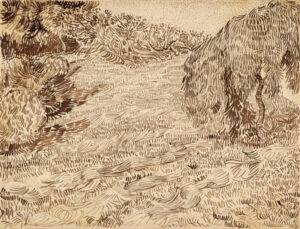
The Metropolitan Museum of Art’s Van Gough in Arles show, which opened to the public in October 18 is both exhilarating and crushingly depressing. What unfolds at the Met is a tragedy of grand dimensions. There has seldom been this show which follows an artist development so intimately on the day to day basis nor one which reveals so clearly the terrible cost of superhuman achievement.
The experience is all the more poignant because Van Gough in this show is clearly not the out-of-control mad genius he is so often portrayed as being. Revealed here is a master draughtsman steadily enlarged and refined his graphic vocabulary, a painter who thoughtfully explored the most up-to-date colour theories, a sensitive, well educated, well read man who played on literary references in his choice of subjects.
Only an artist in full possession of his faculties could have completed in just over a week the magnificent series of five large landscape drawings which are the centrepiece of the exhibition. Never before shown together, these works depicting the environs of the ruined abbey of Montmajure were intended to be Van Gough’s contribution to paying off go Gaugin’s debts. Not one of them sold, but for breadth of vision, for compositional invention, the richness of texture, these panoramic reed pen and ink vistas rival anything Bruegel or Rubens have to offer.
Even after his mental breakdown, van Gough was still remarkably lucid. This view is depression on leaving the museum was not caused by the self-portrait in the last gallery. Although mutilated by his own hand and obviously numbed by cold, van Gough the artist triumphs over van Gough the madman in this soaring the honest picture. If the red, green, violet, and yellow, brilliantly woven together in complimentary counterpoint, stand for the diverging emotions warring in the artist’s soul, they also stand for his ability to transcend these emotions in the creation of majestic colour harmonies.
No, it was the Mets appalling commercialisation of a profoundly serious exhibition that provoked distress. The shop through which visitors must pass on their way out of the show raises tastelessness to new heights. Cheap scarves blazoned with quotes from the master, picture puzzles of sunflowers, tawdry knickknacks, are hawked with a blatant, sentimentalised ring hard sell which makes a travesty of the new Mets tax exempt status.
The New York Museum’s efforts to milk van Gough’s tragedy for all it is worth goes even further. In the hope no doubt of whipping up public demand, the Met opened the exhibition to the press and sundry in the month before the actual public opening. And weeks before the press were allowed in, more than $430,000 four dollar tickets for van Gough in Arles went on sale at Tickettron locations all over the country.
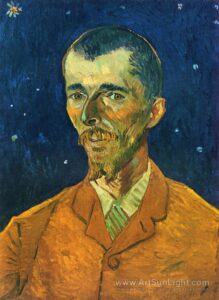
Lured by this blockbuster bait, some 430,000 visitors will no doubt pay their money and obediently enter during the appointed half-hour to mill along with multitudes of their fellow art lovers. If they are lucky they may even catch a glimpse of van Gough’s paintings and drawings over their heads and shoulders of other moving bodies in the snail’s paced stampede.
But how many people will be able to linger long enough to absorb the important lessons there to be learned about the dimensions of the human spirit? How many artists will be able to return again and again to the exhibition, so that they can take the full measure of van Gough’s greatness as a goal for which to strive? How many lost souls will be confronted by the intense humanity of these paintings and drawings? How many children will discover for the first time what a line or a colour can mean to the expression of their innermost feelings? Aren’t these things what an art museum is for?
The circus which the Met has created around van Gough in Arles seems expressly designed to elicit only the most superficial response. It is said that Mark Rothko committed suicide in part because of his inability to control the circumstances under which his paintings might be seen. If any nightmare could justify Rothko’s fears, it is surely this one.
This is doubly unfortunate because the show itself is such a sterling example of the way art historical scholarship can add to our understanding of an artist. Often heavily biographical exhibitions (and this is one of them) tend to place too much emphasis on supposed correspondences between works of art and the artists emotional life.
Van Gough has been particularly victimised by this treatment. Museum docents love to pollute the minds of schoolchildren with such statements as “you can tell from the wiggly lines of paint and the strong colours the van Gough was really upset when he painted this.”
However, it is the artistic breakthroughs, not the emotional breakdowns that create the drama of van Gough in Arles. Guest curator Ronald Pickvance has done a superb job of establishing an exact chronology of van Gough’s artistic activity during this most important period of his life. From January 1888 to May 1889, in spite of the most extreme fluctuations of physical and mental health, van Gough kept up the pace of creation unequalled in the 19th century. The 142 works in the exhibition were chosen from some 200 paintings and over 100 drawings and watercolours completed during his 15 month sojourn in the southern French city of Arles.
It is only because the artist also wrote at least 200 long and profusely illustrated letters from Arles to his cherished younger brother and numerous artist friends that Mr Pickvance was able to date the works so exactly. Extensive quotes from these letters, which constitute an artistic achievement on their own, make the catalogue an essential accompaniment to the exhibition
…
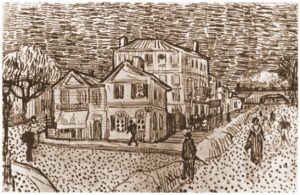
It was in January 1888 that Vincent van Gough decided to leave Paris for the more healthful climate of southern France. Exhausted by the cold weather, debilitated by drinking bad wine and smoking cheap tobacco, he felt he had absorbed enough the artistic firmament of the city. Besides, his turbulent personality was straining the tender relationship in enjoyed with his art dealer brother Theo, who supported him. Van Gough hoped to benefit from a period of solitude.
With the exception of sunflowers, a vigourous oil of contrasting blues and yellows, the Parisienne works in the prologue of the exhibition seem startlingly weak. In fact, the basket of apples and Japonaiserie: the courtesan look like the work of a second-rate painter. Certainly, if these and the works which immediately followed his arrival in Arles in January to 20th 1888, were all that we knew of van Gough, 20th-century hagiography would be missing a major figure.
If he was expecting healing southern warmth, van Gough was disappointed. He was greeted by about 15 inches of snow and a cold snap which lasted nearly a month. But spurred both by his own ambition and his desire to justify Theo’s financial support, he set to work immediately on a countless of the snowy landscape.
The painting and the series of orchards in Bloom which follow a month later lack the coherence and power of his later work. Van Gough seems uncertain as to how to organise his space; his brushstrokes are confused and jerky. However, in his letters he seems well aware of his deficiencies.
“At the moment I am absorbed in the blooming fruit trees, pink peach trees, yellow white pear trees,” he wrote to Emile Benard on 9 April. “My brushstroke has no system at all. I hit the canvas with irregular touches of the brush which I leave as they are… I’m inclined to think that the result is so disquieting and irritating as to be a godsend to those people who are fixed, preconceived ideas about technique.”
The best proof of van Gough’s desire to get his spatial organisation under control of the series of drawings he did in April and early May with the aid of a perspective device. In these we also begin to see the elaborate system of marks, dots, cross hatchings and slashes with which he differentiated his spatial planes. Although the flat landscape and rich vegetation around the old French town reminded van Gough of Rembrandt’s and Ruisdhal’s Holland, its essence was elusive. It took him some months to internalise its rhythms and patterns.
Then in May he made one of those startling leaps forward that seem to characterise his progress. The first clear evidence of this new stage in his development is still life with coffee pot, a brilliant painting, seldom seen in public, which belongs to a private collection in Switzerland.
Many things about this campus market is special in van Gough’s oeuvre. Not only did he characterise it as “something quite apart” in his letters, it also is one of the most carefully painted and finished works in the exhibition. Van Gough even enclosed the still life in a white and red painted frame to give it importance and, in a rare gesture, signed it Vincent in red on the upper left hand corner.

Still life with coffee pot is monumental, spatially complex, totally controlled and wonderfully rich in its variations of blue and yellow. It is also a touching memento of van Gough’s first and only independent home, his famous yellow house at 2 Place Lamartine. He proudly reported to Theo on May 8 the purchase of “things for making a little coffee and soup at home.” This painting celebrates the occasion.
Other important breakthroughs follow. A short visit to the seaside town of Stes Maries resulted in a number of important works, among them the vigourous, highly stylised drawing fishing boats on the beach. In a letter to his brother, van Gough boasts, “I’ve only been here a few months but tell me this: could I, in Paris have done the drawing of the boats in an hour? Even without the perspective frame, I do it now without measuring, just by letting my pen go” unfortunately the painting of the same subject, which has always been a public favourite, could not be obtained the exhibition.
A little later on in June, van Gough’s developing mastery shows up even more clearly in a magnificent series of 10 harvest canvases, six of which are in the exhibition. Painted outside in the full heat of the sun, the vigourous rhythmic brushstrokes echo the crossed hatch textures that pulse across his drawings. The compositions have been powerfully focused by exaggerated perspective and violent contrasts of violet and yellow.
Months later van Gough was to write to his brother, “instead of eating enough and at regular times, I kept myself going on coffee and alcohol. I admit all that, but all the same it is true that to attain the high yellow note that I attend last summer, I really had to be pretty well keyed up.”
This, of course, is a crucial point. Was this statement van’s rationalisation for self-destruction or was his self-sacrifice really necessary to his fevered production? Whatever the truth, he certainly pushed himself unmercifully through June, July, and August. Besides the harvest series the Montmajure drawings, and a series of gardens, he
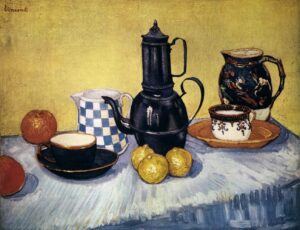
began to do portraits of local characters, his friend Joseph Roulin, the Republican postman and as a Zouave soldier – “a boy with a small face, a bull neck and the eye of the Tiger.” He also executed numerous drawings after his paintings to send to his friends, refining to the point of virtuosity his reed pen technique.
All this while van Gough was tremendously excited by the possibility of an extended visit from Gaugin. He discussed endlessly with Theo via the post his plans to start a colony of artists in Arles begged his brother to extend financial support to Gaugin as well as to himself. This Theo ultimately agreed to do in return for a painting a month from Gaugin. Since Gauguin’s work, unlike van Gough, occasionally sold, the bargain was not such a bad one.
An important aspect of van Gough’s personality was his exceptional sensitivity to other people’s opinions and tastes. One can even see it operating in the graphic works he sends off to his friends. For the artist Emile Benard who hates Seurat and pontillism, van Gough senses his textual dots and makes his drawings more structural and Cezannesque. For John Russell, an Australian painter and collector, he stresses delicacy of tone and a great range of textural effects. In one drawing for Russell, garden with weeping tree, van Gough seems to deliberately evoke the English landscape tradition.
His extreme sensitivity was to prove devastating when van Gough and Gaugin were actually living and working together. But anticipation of the imminent arrival of his revered older friends spurred van Gough to new prodigies or production. During September, he devoted a great deal of thought to the decorations for Gauguin’s room in the yellow house, and ultimately completed for extraordinary autumnal canvases which he called the poet’s garden. Brought together here for the first time, there are among the most beautiful he ever painted.
It was also during the early fall that van Gough began to most clearly elaborate his theory of correspondences between colour and emotional states. About the night Café, he wrote to his brother, “I have tried to express the terrible passions of humanity by means of the red and green.” His colours for portrait of Eugene Boch were meant to express his love and admiration. “By the simple combination of the bright head against the rich blue background,” he wrote, “I get a mysterious effect, like a star in the depths of an azure sky.”
Gauguin finally arrived on October 23. While there is no record (in the catalogue at least) of his response to van Gough’s paintings, the effect of his powerful personality shows up almost immediately on the younger artists canvases. In order to save money Gaugin instituted the practice of buying cheaper colours and preparing canvases from rough burlap. But the unprecedented dullness and flatness of van Gough surfaces and the pictures he completed shortly after Gauguin’s arrival cannot be only attributed to the material change. Such paintings as Lee Alyscamp show clearly that van Gough’s nerve had failed in the face of go-go and decorative, almost abstract compositions.
Worse followed. As the result of Gaugin’s prodding, van Gough’s attempted to work from his imagination with disastrous results. Memory of the garden at Etten, the dance hall and spectators in the arena are all weak and confused compositions.
It was only when van Gough ignored Gauguin’s precepts in his portraits of the Roulin family and Madame Gimoux (L’Arlesienne) that he got back his confidence. And even in these justly famous pictures, there appears a growing alienation from his subjects that was certainly not evident in the idealising portraits he completed during the summer. Madame roulin with baby is almost brutal in its handling of the drawing and colour.
The end of van Gough’s long anticipated collaboration with Gaugin came swiftly. Already threatened by the older artists dominating ways, van Gough was further upset by a portrait of himself at work at his easel painted by Gauguin in early December. “It is certainly I, but it I gone mad,” he allegedly commented. On the evening of December 14, van Gough threw a glass of + that Gauguin’s head and go again decided to leave. A few days of calming student and he changed his mind, but then after five days of continuous rain on December 23, violence erupted again.
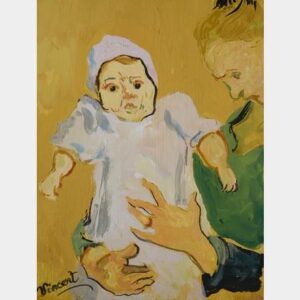
According to Gaugin’s reminiscences 15 years later, it was after dinner that van Gough followed him into the garden and (the poet’s garden of the Place Lamartine, the site of the younger artists most ardent hopes) and threatened him with a razor. Gaugin simply stared at him and van Gough returned alone to the yellow house
While no one knows exactly what happened in the interval at 11:30 PM the artist appeared at the door of the local brothel and asked for a girl named Rachel. When she appeared he presented her with the lower part of his left ear, saying “keep this object carefully,” and left. The next morning he was discovered by the police in his bed almost dead from loss of blood.
Van Gough was never really able to live on his own again. After protests from the neighbours yellow house was closed by the police and its contents ultimately dismantled. Finally in May after months of virtually living in the hospital, van Gough decided to commit himself to the asylum at Saint Remy , a town not far from Arles.
In retrospect it is quite amazing that an exhibition of van Gough’s works in Arles has never before been mounted. So many of his most important paintings date from that period, yet public attention has always been focused on the artworks he completed in Saint Remy after he was certifiably insane. It was easier, perhaps, to explain their intensity and power stemming from the overwrought brain of a madman.
This exhibition gives the lie to that theory. At the very least, it strongly suggests that we should consider the contrary proposition, that his madness was in fact a collapse resulting from the enormous strain of his work. “You will perhaps understand that what would reassure me in some fashion as to my illness and the possibility of a relapse,” van Gough wrote to his brother on January 28, 1889, “would be to see that Gauguin and I had not exhausted our brains for nothing, but that some good canvases have come out of it.”
Jane Adams Alan was the art critic for the Washington Times and a founding editor of the Art Lantern.
Volume 33 no 2 November / December 2018 pp 15-19
